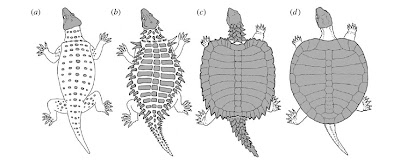 Odontochelys is the new basalmost triassic turtle, with a plesiomorphic ("primitive") presence of teeth (hence the name) and a most remarkable transitional aspect: It has a perfectly formed plastron yet no carapace. Odontochelys only presents the dorsal midline of the neural plates of the carapace, that are close to the neural spines but remain separate (which is not the case in more derived turtles).
Odontochelys is the new basalmost triassic turtle, with a plesiomorphic ("primitive") presence of teeth (hence the name) and a most remarkable transitional aspect: It has a perfectly formed plastron yet no carapace. Odontochelys only presents the dorsal midline of the neural plates of the carapace, that are close to the neural spines but remain separate (which is not the case in more derived turtles).Lets briefly recall what some evil saltationists (paleos and evo-devo's) have said about this. I remember Bob Bakker's book "The dinosaur heresies" (1986). There, he mentions the fact that in turtles the pectoral girdle is actually under the ribs, and points out that this qualitative aspect is hard to imagine to have occurred in more than a single step.
What can development tell us of all this? First, the plastron is derived from the neural crest, unlike the carapace, which is derived from a mixture of dermal bone and ribs. Second, the plastron ossifies before the carapace. Odontochelys reveals that this embryological and temporal separation also reflects a phylogenetic sequence. Scott Gilbert (yes, the book guy) points out that in turtles, the ribs have shifted dorsally, to developing within the dermis, a unique trait within amniotes. If an embryonic rib is experimentally inserted in the dermis of a chicken embryo, the result is ossification
 of the dermis surrounding the rib. Because of this paracrine effect on the dermis, Gilbert hypothesized that a single-step shift of the ribs to the dermis could have induced the origin of a well-formed carapace.
of the dermis surrounding the rib. Because of this paracrine effect on the dermis, Gilbert hypothesized that a single-step shift of the ribs to the dermis could have induced the origin of a well-formed carapace.Some regard this hypothesis as incompatible with the hypothesis that an exoskeleton of separate dermal bones preceded the origin of the carapace. This incompatibility in my opinion is not quite so; dermal bones could have existed or not previous to the shift of the ribs closer to the dermis; the shift could have led to a single carapace. Critics to Gilbert's hypothesis have pointed out that in the carapace of the early (very fragmentary) triassic turtle Chinlechelys, ribs are not "immersed" in the carapace but run immediately below the surface of the dermal plates. However it is possible that this was sufficient for the paracrine effect leading to a single carapace "shell". Unfortunately we cannot know if the pectoral girdle was already under the ribs in Chinlechelys.
Even admitting the possibility of previous ostederms, Odontochelys is certainly something unexpected from the more "gradualist" perspective, which was "hoping" early stages of dermal armor would go back to remote Pareiasaur-like ancestors (see figure below). The full plastron of Odontochelys is pretty derived, yet this species has no "coat" of osteoderms.

From Joyce et al 2007. Odontochelys indicates that "coats" of osteoderms as in a) and b) did not precede the origin of the plastron
Odontochelys is consistent with the notion that a shift in the position of the ribs to greater proximity to the dermis could have induced a"radical" extension of dermal bone, from mere dorsal midline of neural plates, to a full carapace; as a third step, superficially attached ribs and dermal bones, became fully integrated with the dermal bone conforming the "true" carapace.
References:
Li C, Wu X-C, Rieppel O, Wang L-T, Zhao L-J (2008) An ancestral turtle from the Late Triassic of southwestern China. Nature 456: 497-501
Joyce WG, SG Lucas, TM Scheyer, AB Heckert, AP Hunt (2008). A thin-shelled reptile from the Late Triassic of North America and the origin of the turtle shell Proceedings of the Royal Society B DOI: 10.1098/rspb.2008.1196
2 comentarios:
There is some controversy about the position of the ribs regarding the pectoral girdle. Unfortunately, it's not clear to me from the fossil of Odontochelys what the position is. Some squashing can also complicate the issue; CAT Scan and some computer reconstructing may help out here.
Some paleontologists have argued that the pectoral girdle in turtles is under the carapace but not necessarily under the ribs, pointing out that the pectoral girdle is positioned very anterior, even since in basal amniotes and has little superposition with the ribs.
Others are arguing the carapace IS there, because the ribs are evidently flattened (they "are" the costal plates)
These arguments, however, which would place doubt on any "radical" transformation, fail to recognize how unique the development of turtle ribs is.
The ribs are immersed in the DERMIS rather than developing in the body cavity as in any other amniote. Let's start from there (I won't even mention the carapacial ridge).
I still think Odontochelys supports a radical step in the evolution of the carapace and rib position. First, ribs that are flattened to the sides exist in the embryonic turtle; the endochondral rib extends periosteal membranes from its sides.
So, the carapace is not "there", at least not in complete from: very plainly, the dermal component of the costal plates is lacking. In Odontochelys, the endochondral part of the ribs is present, but in derived turtles, the dermis around the ribs ossifies forming spiculae, with disperse osteocytes (without ossification centers, but form the ribs)
Since Odontochelys is lacking the dermal component of the costal plate, I would tend to assume it represents a stage previous to the closer proximity of the ribs to the dermis that would have produced greater induction of dermal bone. It is possible that proximity of endocondral bone was only sufficient along the neural spine to induce dermal plate ossification.
yoo.. funny thread.
Publicar un comentario